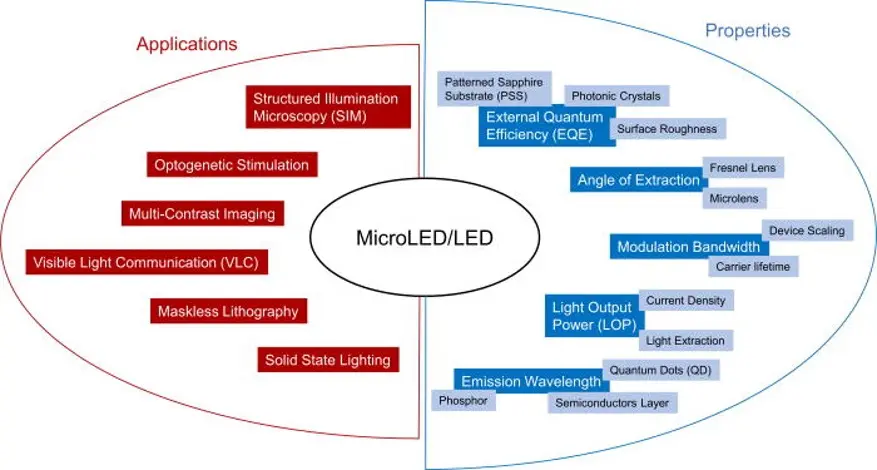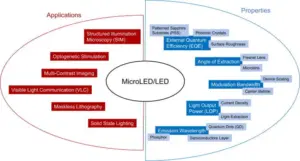The integration of MicroLEDs and LEDs in the electro-optical field is rapidly gaining attention due to the potential for enhanced performance and a wide range of applications. MicroLEDs, smaller counterparts to traditional LEDs, offer numerous benefits, such as high resolution, low power consumption, and improved overall performance. Researchers Vikrant Kumar and Ioannis (John) Kymissis of Columbia University have explored various electro-optical integrations of MicroLEDs in a paper explaining each one in a manner that we can all appreciate and enjoy.

High-Resolution Displays with MicroLED Technology
One of the most promising applications of MicroLED technology is in high-resolution displays. MicroLEDs can deliver superior color gamut, higher brightness, and better contrast due to their small pixel size. The integration of these tiny LEDs enables the creation of displays with a more detailed and immersive visual experience. This technology has immense potential in devices such as smartphones, televisions, and even virtual reality (VR) or augmented reality (AR) headsets. The enhanced visual experience offered by MicroLED displays could redefine the way we interact with technology.
Transforming Wearable Devices
The incorporation of MicroLEDs into wearable devices can significantly improve energy efficiency, extend battery life, and boost screen quality. This is particularly beneficial in smartwatches and fitness trackers, where high-resolution displays and minimal power consumption are crucial. Furthermore, the thin and flexible nature of MicroLEDs makes them perfect for integrating into wearable technology, enabling sleeker and more comfortable designs.
Revolutionizing Automotive Lighting
MicroLEDs have the potential to transform automotive lighting by offering more precise control over light distribution and intensity. This technology can lead to improved safety features, such as adaptive headlights that adjust their brightness and direction based on driving conditions. Customizable interior lighting can also enhance the driving experience, creating a personalized atmosphere inside the vehicle. The integration of MicroLEDs in automotive lighting systems is expected to set new standards for both safety and aesthetics.
Biomedical Applications and Optogenetics
MicroLEDs can be utilized in various biomedical applications, including optogenetics, a technique that controls cellular activity through light stimulation. The small size and low power consumption of MicroLEDs make them ideal for integration into implantable devices, allowing for more precise and efficient control of biological processes. The electro-optical integration of MicroLEDs in biomedical applications opens new possibilities for treatment and diagnosis, potentially leading to groundbreaking advancements in healthcare.
High-Speed Data Communication and Optical Interconnects
The electro-optical integration of MicroLEDs can enhance high-speed data communication systems, such as optical interconnects used in data centers and telecommunications. By replacing traditional electrical connections with optical connections, MicroLED-based systems can transmit data at higher speeds, with lower power consumption and reduced signal loss. This improvement in efficiency and reliability of data transmission is expected to drive significant advancements in communication technology.
The LED Revolution
The integration of MicroLEDs and LEDs in electro-optical applications promises to revolutionize various fields, from display technology to biomedical applications. As research and development progress, we can expect to see more innovative solutions and applications emerge, enhancing our daily lives and expanding the boundaries of technology.
Reference
V. Kumar, I. Kymissis; MicroLED/LED electro-optical integration techniques for non-display applications. Applied Physics Reviews 1 June 2023; 10 (2): 021306. https://doi.org/10.1063/5.0125103

